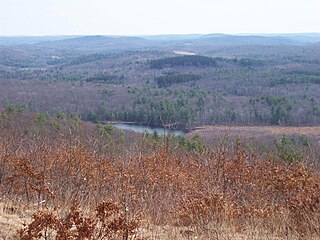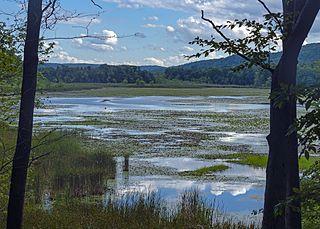
The National Natural Landmarks (NNL) Program recognizes and encourages the conservation of outstanding examples of the natural history of the United States. It is the only national natural areas program that identifies and recognizes the best examples of biological and geological features in both public and private ownership. The program was established on May 18, 1962, by United States Secretary of the Interior Stewart Udall.

The Seney National Wildlife Refuge is a managed wetland in Schoolcraft County in the U.S. state of Michigan. It has an area of 95,212 acres (385 km2). It is bordered by M-28 and M-77. The nearest town of any size is Seney, Michigan. The refuge contains the Seney Wilderness Area and the Strangmoor Bog National Natural Landmark within its boundaries.

Mohawk State Forest, also known as Mohawk State Forest/Mohawk Mountain State Park, encompasses over 4,000 acres (1,600 ha) in the towns of Cornwall, Goshen, and Litchfield in the southern Berkshires of Litchfield County, Connecticut. As overseen by the Connecticut Department of Energy and Environmental Protection, the area is used for hiking, picnicking, and winter sports by the public, while being actively managed to produce timber and other forest products.

Pachaug State Forest is the largest forest in the Connecticut state forest system, encompassing over 27,000 acres (110 km²) of land. It is located on the Rhode Island border in New London County, and parcels of the forest lie in the towns of Voluntown, Griswold, Plainfield, Sterling, North Stonington, and Preston. The forest was founded in 1928, but most of the land came from purchases made later during the Great Depression. It is named after the Pachaug River, which runs through the center of the forest. The forest is part of the Northeastern coastal forests ecoregion.

Cowles Bog is a 4,000-year-old wetland complex in Indiana Dunes National Park, near Chesterton, Indiana. It is named for Henry Chandler Cowles who did his pioneering work in ecology and ecological succession here. His work brought international attention to the area which led to efforts to preserve the Indiana Dunes. It was designated a National Natural Landmark in 1965. It contains bog, fen, marsh, wet meadow, swamp, and pond habitats.

Cedar Bog State Nature Preserve is a fen left behind by the retreating glaciers of the Wisconsin glaciation about 12,000-18,000 years ago. A protected area of about 450 acres (180 ha) of fen remains from the original area of approximately 7,000 acres (28 km2).

Mendon Ponds Park is a county park located southeast of Rochester, New York within the suburban towns of Mendon and Pittsford. At over 2,500 acres (10 km2), it is the largest park in Monroe County. It was designated a National Natural Landmark in 1967 in recognition of its unique glacial geology. Monroe County acquired the first 1,400 acres of the park in 1928 for $185,000 (USD).

Brown's Lake Bog is a dedicated Ohio state nature preserve owned by The Nature Conservancy. It is one of the few remaining kettle peatlands in the U.S. state of Ohio. It has a kettle lake, kame, and a floating sphagnum moss mat. Public visitation is allowed.

Moss Lake Bog is an 84-acre (34 ha) site containing a 15-acre (6.1 ha) glacial kettle lake located in the town of Caneadea, New York, outside Houghton. Over time, sphagnum moss has grown over the open water, turning it into an acidic bog. It is managed by The Nature Conservancy as part of Moss Lake Preserve, and was declared a National Natural Landmark in 1973.

Thompson Pond in Pine Plains, New York is a 75-acre (30 ha) 15,000-year-old glacial kettle pond at the foot of 1,403-foot (428 m) Stissing Mountain. It is the source of Wappinger Creek, a tributary of the Hudson River that drains much of Dutchess County.

Zurich Bog is a 490-acre (2.0 km2) sphagnum bog in Arcadia, New York. Lyman Stuart and the Newark School District donated the land on December 10, 1957 to the Bergen Swamp Preservation Society which had been created in 1935 to preserve the similar Bergen-Byron Swamp. The bog has been the focus of scientific interest since the 19th century, and was declared a National Natural Landmark in May 1973.

Beckley Bog is a sphagnum-heath-black spruce bog located near Norfolk in Litchfield County, Connecticut. It is the southernmost sphagnum heath bog in New England. The peat moss is over 51 feet deep. It was declared a National Natural Landmark in May 1977.

The McLean Game Refuge is a 4,400 acres (1,800 ha) nature preserve with the overwhelming majority of the land being in the town of Granby, with smaller tracts of land on the Granby border in Simsbury and Canton, Connecticut. Senator and Governor of Connecticut, George P. McLean had purchased the land throughout his life. It was left to the McLean Fund upon his death in 1932 and remains open to the public today. In November 1973, 1,800 acres (730 ha) of the Refuge were designated a National Natural Landmark.

Pootatuck State Forest is a Connecticut state forest located mainly in the town of New Fairfield with a small fraction in Sherman. Recreational activities include hiking, mountain biking, letterboxing, hunting, birdwatching, snowmobiling, and cross-country skiing. The main forest property borders on and can be accessed via trails from the adjacent Squantz Pond State Park.

Audubon Sharon, which consists of the Sharon Audubon Center and the Emily Winthrop Miles Wildlife Sanctuary, is a wildlife sanctuary of the National Audubon Society in Sharon, Connecticut. The 1,147 acres (464 ha) of the Sharon Audubon Center property is primarily forest land with two ponds with 11 miles (18 km) of trails for visitors to use. Its facilities include a raptor aviary, an herb garden, a garden to attract bird and butterflies, a sugarhouse, a memorial room to Hal Borland, a small museum and store. Sharon Audubon Center is located at 325 Cornwall Bridge Road.















